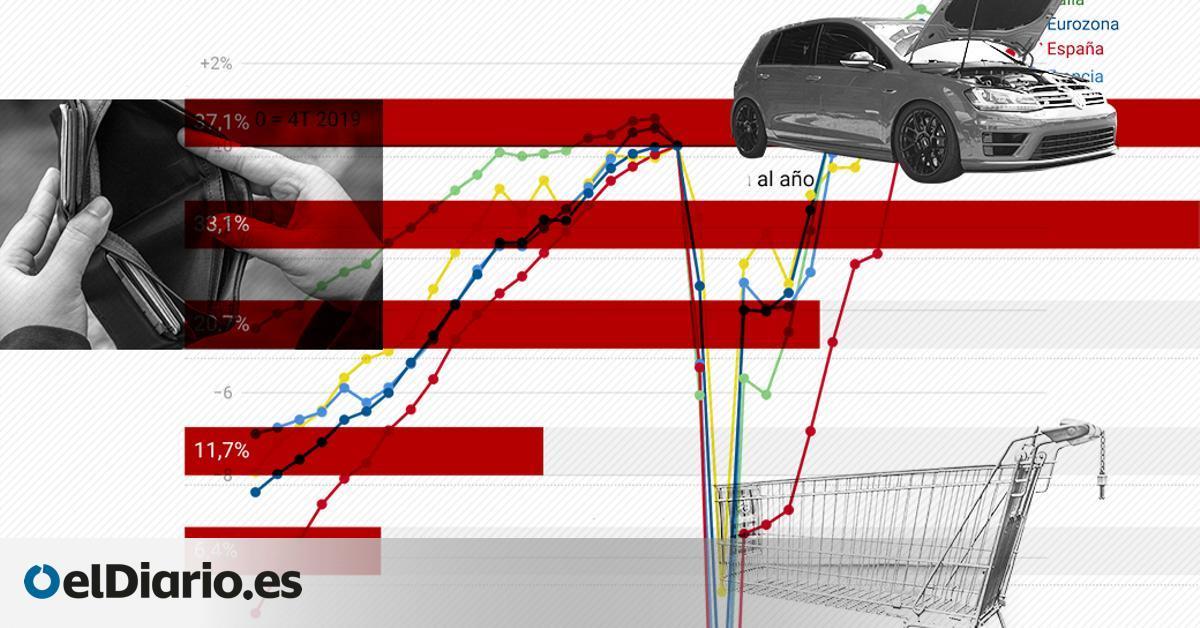
The economic data known during the last week could be very representative of the economic battle of 2024. On the one hand, the first certainties of activity suggest that our country will once again lead economic growth (GDP) among the large European economies this anus. On the other hand, the 2023 Living Conditions Survey confirmed that the social response to the chained losses of the pandemic and the Russian invasion of Ukraine has brought inequality to a minimum. However, inflation and the housing market continue to damage purchasing power and cause dissatisfaction among many working families.
The survey on “living conditions” by the INE, one of the best ‘photos’ of poverty produced in Spain, showed last Monday the great economic paradox of the current situation. The increase in the Minimum Interprofessional Wage (SMI), pensions, the creation of jobs, less precariousness after the 2021 labor reform and the rest of the income protection measures deployed by the coalition Government have reduced the gap between the richest and the poorest.
As seen in the first graph, inequality skyrocketed after the great financial crisis of 2008, with austericidal policies. The reality is very different today. On the other hand, the same survey also includes the blow that only the monster of inflation can deliver. The lack of meat, chicken and fish has increased to maximum levels, up to 6.4% of households, and energy poverty has risen to slightly above 20%, among other alarm signals.
“How do we explain that inequality decreases, real average income is maintained, and these indicators of material poverty increase? The most plausible explanation is that in this period there has been a greater increase in the lowest incomes (thanks to the increase in pensions and the SMI) than in the rest of salaries, which has led to a fall in inequality. However, the parallel increase in prices has generally undermined purchasing power, causing stagnation in real average income,” CGT explains.
“In addition, the fact that inflation has occurred very markedly in some specific sectors, such as food or energy, helps explain that, although this increase is moderated in the weighting of the general CPI, underestimating its incidence “The increase in prices is captured in specific indicators of consumption and material scarcity,” continue the experts of the anarcho-syndicalist organization.
Leadership in economic growth
All the forecasts of national and international organizations, from the International Monetary Fund (IMF), through the analysis centers, to the Government, agree that Spain will be the large economy of the European Union (EU) that advances the most in 2024 (with a growth of between 1.5% and 2%, according to the most and least optimistic visions), after also doing so in 2021, in 2022 and in 2023. It is expected that tourism and the rest of the foreign sector (in full transformation, as it sells more services than ever) resist international weakness. It is expected that domestic consumption will be the protagonist in aggregate terms due to the strength of the labor market. And the outbreaks in company investment are also seen due to the deployment of the Recovery Plan.
“But [la española] It will also be one of the economies that will suffer higher inflation,” laments Ángel Talavera, chief economist for Europe at Oxford Economics. “Given the strong rejection of inflation, solid growth is probably not enough to keep most people happy if they feel that prices remain too high and that their personal economy is not improving, which has consequences for confidence. ”, continues this expert. Beyond GDP, the economic battle is fought in people’s pockets.
The different estimates project an average inflation in Spain close to 3%, from 3.5% in 2023, 8.4% in 2022 and 3.1% in 2021. That is, prices will rise less this year, but They will continue to do so at dizzying levels, after 3 years of increases. Salaries have been improving little by little, but the same projections indicate that the increases will be insufficient to recover all the lost purchasing power, on average.
On the one hand, in perspective, it is true that Spain has weathered the price crisis better than most European economies. In fact, accumulated inflation since January 2021 is 16.3%, compared to the almost 20% average in the EU.
The problem in “the last mile” of this process is that the sectors where the largest increases have been concentrated in our country, food, hospitality and other services, barely moderate the increases and are far from lowering prices. This same week, the INE published the inflation data for February, which was reduced by 6 tenths to 2.8%, compared to the same month in 2023, and after 3.4% in January. Mainly, due to the lower cost of electricity, thanks to lower demand due to higher than normal temperatures and generation with renewable sources.
Regarding food, Statistics mentioned “stability.” The details of prices in supermarkets and stores in February will not be known until March 14. In January, they rose 7.4% year-on-year. In December, 7.3%. A year ago, in February 2023, they reached a maximum of 16.6%, which explains the “stability” described by the INE. That is, the calculation starts from a very big jump.
“In 2023, nearly 4.3 million people were in a situation of severe material and social deprivation, and up to 3 million could not afford adequate food, which is related to the intense rise in food prices, of a 25% in the last two years,” they insist in UGT. “In this context, the union denounces that companies continued to expand their benefits, which in 2023 exceeded the pre-pandemic level by 48%. This is largely explained by the disproportionate rise in business margins, generating enormous pressure on the price of some products. Putting a cap on them, especially in some sectors, continues to be a fundamental axis to guarantee fairer and more affordable prices for the working class,” they add.
In March, electricity is expected to once again add to the price increases, which are again projected above 3%, because its VAT has returned this month to 21%, the pre-crisis level. In January, the Government already raised it from 5% to 10%, as part of the withdrawal of shock measures to meet the budget deficit objective (the difference between public income and expenditure) of 3%, after the return of fiscal rules to the EU.
Furthermore, the restitution of the fiscal corset has led the second coalition Executive to increase the VAT on gas from 5% to 10% in the first quarter, and then it will return to 21%. Or to increase the special electricity tax (IEE). Until June, for now, the VAT reduction on basic foodstuffs is maintained, as well as aid to vulnerable consumers for heating and electricity. Discounts on public transport also continue. Its expiration will cause another jump in general inflation in the second half of the year. Meanwhile, the risk with electricity, fuel or gas is their volatility in a context of geopolitical instability.
The paradox
“The data from the latest INE Living Conditions Survey reflect an increase in the average income of families, but this does not translate into an improvement in living conditions,” argues Thomas Ubrich, sociologist on the Cáritas study team. Spanish. This “is due to the expenses that families have to face, of course food, the prices that increase, but above all what is related to housing, both in access to and maintenance of it,” he continues. .
“In recent years we have seen a trend towards a reduction in the ability of families to face unforeseen expenses,” highlights this expert. “It is important that public administrations guarantee the right to an adequate standard of living by supporting not only the income but also the expenses of families, specifically in access to and maintenance of housing,” says Thomas Ubrich.
Access to housing is a cornerstone of the economic paradox that is occurring in Spain. One in three tenants spends more than 30% of their income paying rent. Likewise, in the mortgage market, the monetary austerity of the European Central Bank (ECB) has triggered the Euribor, making new loans and those signed at a variable interest rate more expensive (70% of the total in our country).
“The risk of poverty in Spain has really been reduced. Another thing is that, in parallel with the evolution of employment and the evolution of salaries, an analysis must also be carried out on how public transfers affect or fail to affect the reduction of poverty in Spain. Because I believe that our income protection model continues to clearly be improved. And I think this also explains part of the lack of access to minimum survival income, even for a part of the vulnerable population of our country,” comments Unai Sordo, general secretary of the Workers’ Commissions (CCOO).
Source: www.eldiario.es

